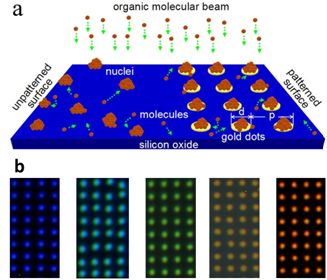
Nanostructured biochemical surfaces
Patterned surfaces with micro/nano sized structures have been demonstrated to be a powerful platform for providing molecular engineering of cellular environments. Increased efforts have been made to study the influence of structured surfaces on cell behaviors such as adhesion, differentiation, proliferation and so on. These studies aim at creating biomimetic environments with defined chemical and physical properties in order to gain deeper understandings on how cells interact with their environment.
We are well experienced in the fabrication of structured surfaces with feature sizes ranging from micrometers down to nanometers, based on bottom-up and top-down strategies, as well as their combinations, and further chemical modifications. The application of these structured surfaces in cell culture has been conducted in our group in the recent years to demonstrate their influence on cell behaviors. For instance, osteoblasts, phytopathegenic fungi Magnaporthe Grisea and Pucinnia Graminis cells show clear alignment along topography patterns made by Langmuir-Blodgett Lithography (LBL); Human embryonic stem cells (hESC), which have the ability to differentiate into three germ layers, differentiate preferably towards neuronal lineage on structured surfaces with linear shapes; the growth of some cancer cells can be effectively depressed on nanostructured surfaces.
In future works, we are going to focus on the fate of embryonic stem cells and cancer cells on structured surfaces - in collaboration with the Max-Planch-Institute of Molecular Biomedicine (MPI Münster) and medical/biological groups of WWU - together with chemical modifications of the surfaces. Furthermore the application of external forces such as mechanical forces and electrical fields is in planning. Based on the understanding of the mechanisms behind the effects, the long term goal is to develop applicable surfaces/interfaces for clinical regenerative medicine.
Reference: Tunable multicolor ordered patterns with two dye molecules.
Wang W, Du C, Bi H, Sun Y, Wang Y, Mauser C, Da Como E, Fuchs H, Chi L. Adv. Mater. 22, 2764-2769 (2010)

